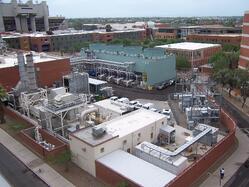The U.S. Environmental Protection Agency’s (EPA’s) plan to regulate carbon emissions is just the latest challenge facing the U.S. electric power system. Technological innovation is disrupting old ways of doing business and accelerating grid modernization. Earlier this year, AEE released Advanced Energy Technologies for Greenhouse Gas Reduction, a report detailing the use, application, and benefits of 40 specific advanced energy technologies and services. This post is one in a seriesdrawn from the technology profiles within that report.
 Combined Heat and Power (CHP), also called cogeneration, generates both electricity and useful heat from the same fuel source. CHP typically involves dedicated equipment to generate electricity, followed by recovery of exhaust/waste heat for use in industrial processes, space heating, or water heating. Any fuel can be used for CHP, including fossil fuels and renewable fuels. In certain industries, onsite “waste” fuels are used for CHP, such as wood chips, bark and sawdust in forest products, blast furnace gases in steel mills, and various process gas streams in refining and petrochemicals. Because thermal energy (steam, hot water) is more difficult to transport than electricity, CHP systems are typically installed at or near a suitable thermal load. Most U.S. CHP capacity is installed at industrial sites, but it is also fairly common at college campuses, hospitals, military bases, and in district energy plants.[1] Housing complexes and commercial buildings also use CHP. So-called micro-CHP can be used in residences and small commercial buildings for water or space heating or for heating swimming pools. CCHP (combined cooling, heating, and power) is a variation of CHP that uses the waste heat to drive a cooling system (via an absorption chiller) in addition to generating heat and power. CCHP can make sense when heating loads are more seasonal and where there are large cooling requirements, resulting in higher overall utilization of waste heat than would be possible just with CHP.
Combined Heat and Power (CHP), also called cogeneration, generates both electricity and useful heat from the same fuel source. CHP typically involves dedicated equipment to generate electricity, followed by recovery of exhaust/waste heat for use in industrial processes, space heating, or water heating. Any fuel can be used for CHP, including fossil fuels and renewable fuels. In certain industries, onsite “waste” fuels are used for CHP, such as wood chips, bark and sawdust in forest products, blast furnace gases in steel mills, and various process gas streams in refining and petrochemicals. Because thermal energy (steam, hot water) is more difficult to transport than electricity, CHP systems are typically installed at or near a suitable thermal load. Most U.S. CHP capacity is installed at industrial sites, but it is also fairly common at college campuses, hospitals, military bases, and in district energy plants.[1] Housing complexes and commercial buildings also use CHP. So-called micro-CHP can be used in residences and small commercial buildings for water or space heating or for heating swimming pools. CCHP (combined cooling, heating, and power) is a variation of CHP that uses the waste heat to drive a cooling system (via an absorption chiller) in addition to generating heat and power. CCHP can make sense when heating loads are more seasonal and where there are large cooling requirements, resulting in higher overall utilization of waste heat than would be possible just with CHP.
CHP has been used in some form for over a century. New York City, for example, has operated a district heating system that uses CHP since 1882. Despite its long track record, CHP only makes up about 8% of U.S. generation capacity (about 80 GW), suggesting that there is ample opportunity for greater adoption. Hospitals and colleges are good candidates for CHP, as CHP systems can continue to generate power during grid outages. For example, incentivized by ConEdison’s lower rate structure for CHP, New York Presbyterian Hospital installed a 7.5 MW CHP system, reducing the amount of power purchased by 80%. The avoided power purchases and overall fuel savings are expected to reduce greenhouse gas emissions by 67,000 tons each year, not including any emissions from construction.
In the United States, average power plant efficiency is about 34%, i.e., roughly 2/3 of the fuel’s energy content is wasted. Best-in-class power plants have efficiencies of about 50% to 55%. By utilizing waste heat, CHP plants can typically achieve overall fuel efficiencies of 75% to 85%, and sometimes even higher. Overall, CHP reduces annual U.S. energy consumption by 1.8% and avoids CO2 emission of 248 million metric tons a year. Should the President’s goal of adding 50 GW CHP to U.S. generation capacity by 2020 be met, an additional 100 million metric tons of CO2 emissions per year could be avoided.
[1] District energy is discussed in more detail in another part of this series.
